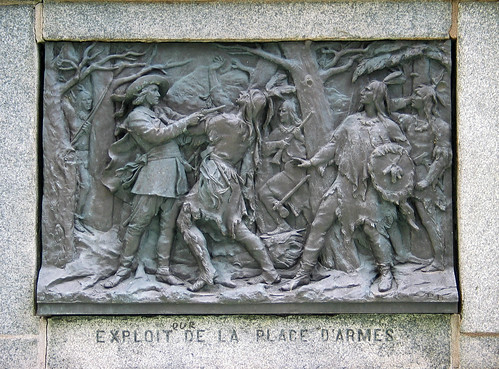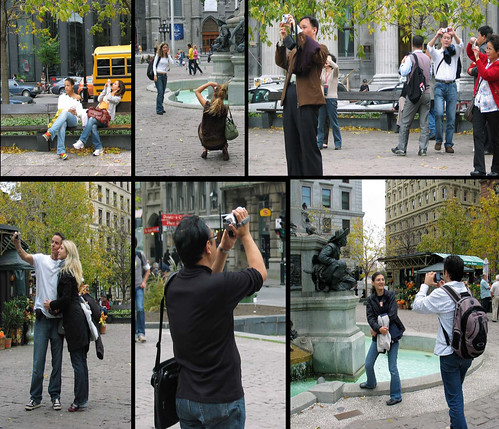Spend a half an hour in the square and you’ll watch this scene on repeat: A tour bus wheezes up to the curb and releases a flood of tourists into the square. They squint up at the twin steeples of the Notre Dame Basilica, take a spin around the statue of our founder, Sieur De Maisonneuve, and snap an obligatory photo. Within moments the tide ebbs as the tourists are rushed back into the bus, and whisked away.
Place d’Armes may once have been the heart of Montreal, but these days it’s just wham, bam, thank you ma’am.

Place d’Armes is like an island awash in a sea of traffic and tour buses.
Fortunately, the city has concluded that this square needs a little TLC. It is currently under renovation and the new plans treat all the space up to the surrounding buildings and even the adjacent streets as an extension of the square.
But perhaps worse than physical isolation, is that this historical, once the core of the city, site has fallen into disuse. Over the centuries Place d’Armes has been used as a military training ground, a market, a garden, and a tramway terminus. Today its function is pretty much limited to a picturesque backdrop for snap-happy tourists.
It’s less clear how the current renovations will add to the “appropriation and livability of the place,” one of their stated objectives. The plans do include some elaborate benches but, like the 1960s design, the they treat the square more like an observatory of historic buildings than part of the city (although to be fair, this may be true of most of Old Montreal.)
I think that it could be as simple as having quality sandwiches and coffee on the site to tempt the local office workers to spend lunch-hour in the square (there is a shop on the site although it appears to have been hobbled together out of scaffolding and offers postcards, potted plants, pumpkins and terra-cotta chickens).
Coolopolis suggests closing Notre Dame street altogether in front of the church (although I think it would be a shame to displace the horse carriages). He also mentions a few underground passages in the area – could they be opened up to extend the tourist experience and intrigue locals?
Another option would be requiring tour buses to stop on Rue Saint-Antoine (except in cases of elderly or disabled visitors.) That would unclog the adjacent streets and allow tourists to get better look at the 3 centuries of architecture that cluster around the square.
Approaching Place d’Armes from St-Urbain affords one of my absolute favourite views in the city:

I did have an opportunity to voice these ideas during Design Montreal’s “Imaginer place d’Armes“ session in 2007. I also suggested putting in some display cases for art or student projects that open up a dialogue about the site’s history: something a bit more dynamic than your humdrum monuments and historic information panels. (My suggestions for the square were voted third place, coming in after a spoken word performance and a soundscape, both by UQAM landscape architecture students. So that’s what how the kids design public spaces these days?)
Read on for some of the info I picked up about the square and the surrounding buildings…
As the historic core of Montreal, Place d’Armes holds traces of the conflicts and waves of colonization that this city has undergone over the centuries.
It is thought to be the site where Montreal’s founder, Paul Chomedey Sieur de Maisonneve, shot an Iroquois chief dead during battle. A statue was erected to honour de Maisonneuve on the 250th anniversary of the city.

“Exploit(eur) de la Place d’Armes.” Subtle graffiti on the de Maisonneuve monument reminds us that history can be controversial and emotionally charged even centuries later (Photo taken in October 2007).
The the Sulpician seminary – which at 325 years old is the most ancient standing structure in the city – flanks the North-West side of the square. The area behind the Notre Dame church was acquired by the Sulpicians in 1693 and used as a market and social gathering place, originally called “Place de la Fabrique.”
The city of Montreal acquired the land in 1836, some time after the original Notre Dame church burnt down, and turned it into a Victorian-style public garden. The Notre-Dame Basilica that we know today dates to 1829 and is located a few meters South of the original church, which would have been in the centre of Notre Dame street. As part of the current renovations, the contour of the original church will be outlined in the paving stones.

Painting of Place d’Armes in 1848, from McCord Museum Archive
In 1847 the imposing Bank of Montreal took its place across the square, as if to epitomize the stand-off between English capitol and French Catholicism.
Within decades, American money also found its way to the square in the form of the New York Life Insurance building, Montreal’s first sky-scraper. At 8 stories, the red stone building towered over the 1887 skyline. Two others, the Duluth and the Royal Trust soon topped it: using new steel-frame technology they reached 10 stories, the building height limit imposed by the City of Montreal until 1920.
The Aldred building, also built by an American company, was originally meant to be 12 stories tall but the design evolved with along with the building height limit until, by the time it was finished in 1931, it had 23 floors. Setbacks were required to allow light to reach the square. (Funny, I’ve always assumed that older buildings like these were shaped more by limits in technology than the urban planning regulations of the era).
Not to be outdone by all the English and American money that had poured into Place d’Armes, the French-Canadian Banque Nationale du Canada finally claimed the entire Western edge of the square in 1967. The rather foreboding tower is made of black granite from Lac Saint-Jean.


2 comments
Interesting that you mention the bus tours pulling up and doing the quick photo shoots and taking off again.
There are some bus tour operators that offer 5 cities in 4 days. How do they do it? They offer that type of “sightseeing” that to me, sounds like the exact opposite of what I’d want in a trip.
There was a great article in the Globe and Mail a few years back by Jan Wong who took one of these trips, but it’s now behind a pay-wall.
Anyway, here’s a small discussion.
http://urbantoronto.ca/showthread.php?t=9006
I enjoyed the pictures and the commentary. I was in the square during the summer (August) but it was pretty much dismantled for the redesign. I’ll be interested to see it once the work is completed.
Has there been any progress on the restoration of the Sulpician Seminary? It’s so important a building but the work seems to be dragging on forever. There was little apparent progress from December when I was last in Montreal. I thought maybe they had run out of funds.
While most of the buildings on the Place pay their way, the Banque Nationale is dreadful, although the Palais de Justice down the way on Notre Dame gives it a run for the money. While I find it an insensitive addition to an otherwise charming square, it has the good grace to be almost invisible. It’s difficult for a thirty story building to make so little impression but it’s almost as though it isn’t there.
One thing, the original Notre Dame Church didn’t burn down. It was dismantled shortly after the new church was completed. The tower remained standing for a while after that. You may be thinking of Notre Dame de Bonsecours on St. Paul which burned and was rebuilt in the 18th century.